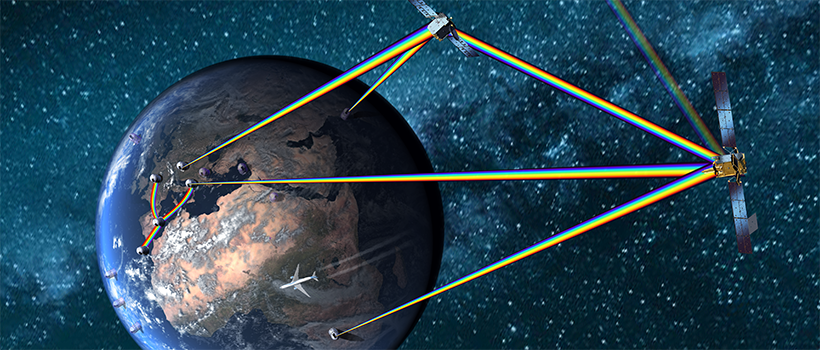ScyLight Industry Day - France
The “Fourth Industrial Revolution” comes with an increasing pace of development and digitalisation, driven - and enabled - by vast amounts of data. Already today, the limitations of conventional networks impact the deployment and end user service capacity, and today’s Satellite Communication Market must innovate in an ever more digital and connected global market.
The “Fourth Industrial Revolution” comes with an increasing pace of development and digitalisation, driven - and enabled by vast amounts of data. Already today, the limitations of conventional networks impact the deployment and end user service capacity, and today’s Satellite Communication Market must innovate in an ever more digital and connected global market.
Optical Communication Technologies are revolutionising traditional, radiofrequency-based space services and could integrate future Very High Throughput Satellites (VHTS) and mega-constellations into terrestrial fibre networks. Not limited by the bottle neck of overlapping and expensive radio frequencies for data up and download, and featuring significantly higher connection speeds than traditional frequencies, the future of Satcom is optical.
ESA’s ARTES (Advanced Research in Telecommunications Systems) programme enables European and Canadian industry to develop innovative products, services, applications and even whole systems that give them a leading edge in a highly competitive global market. The Strategic Programme Line (SPL) on t. The Strategic Programme Line (SPL) on Optical and Quantum Communication “ScyLight” was conceived to support and stimulate the next frontier for space-based communications of the future.
The French ScyLight Industry Day will invite space sector newcomers and established actors alike to discuss current CNES and ESA activities, engage and understand the plans of the HydRON Phase A Primes, as well explore opportunities for French industry in optical and quantum communication in an in-person event. ESA will present its vision towards the upcoming Ministerial Council of ESA (CM22), as well as technology roadmaps, and current plans for a high-throughput optical space network (HydRON).
The event will require registration, but will be free of charge. Participants may present their capabilities or their business focus. We welcome pitches, technical talks as well as new ideas for partnerships, technologies that are currently missing from roadmaps and to showcase commercial collaboration opportunities. Please indicate your wishes in your registration, and help us understand if you wish to join in person or online.
DATE AND PLACE
The event will be a hybrid meeting, allowing for in person as well as online attendance. More details will follow. The event will take place on 7 September and is foreseen to last for half a day.
DRAFT AGENDA (to be confirmed)
09:00 09:15 Link Open – Audio test possible
09:15 10:15 Opening session
Welcome by CNES and SPL manager (Jean-Philippe Taisant and Harald Hauschildt) – 15’
Overview: Optical communications roadmap in France (Frederic Lacoste (TBC)) – 15’
HydRON Demo System proposal (ESA) – 15’
Q&A to CNES and ESA
10:15 10:30 Coffee Break
10:30 12:45 Industry Presentation Session
HydRON Phase A/B1 status (Thales Alenia Space) – 30’
HydRON Phase A/B1 status (Airbus Defense and Space) – 30’
Pitches by French industry (5min per pitch)
12:45 Q&A and wrap-up (all)
13:00 End



